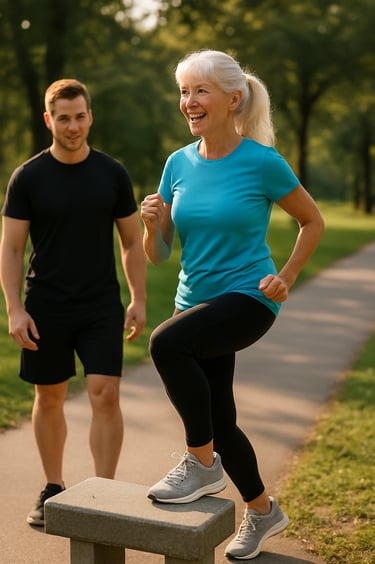HIIT vs Steady State: The Brain-Body Showdown for Seniors
Compare a senior-friendly showdown: HIIT vs. steady-state cardio. Learn how combining both may protect the brain, boost fitness, and honor your joints.
Bruce R Black
10/14/20252 min read


Alright, fellow active agers, buckle up — today we’re throwing down the gauntlet in the ultimate exercise duel: HIIT (High-Intensity Interval Training) vs Steady State Cardio. Which is better for your heart, muscles, and especially your brain? The answer: it depends. But spoiler alert: you don’t need to bet your joints on it.
In this post, we’ll unpack the latest science, show what’s safe and smart for seniors, and help you build a hybrid plan that gives your brain and body the love they deserve.
What the Research Says (Without the Snooze Button)
🧬 HIIT can “turn back” aging signals
A randomized controlled trial in adults 40–65 found that just one month of HIIT reduced an mRNA-based measure of biological age. That’s molecular swag. (PMC)
🚴♂️ HIIT often wins for intensity metrics
In older adults and those with heart issues, HIIT tends to boost cardiac performance, VO₂max, and ejection velocity more than moderate continuous exercise. (PMC)
🧠 HIIT and cognition: promising but cautious
A pilot HIIT program called APEX in older adults showed improvements not just in endurance but in information processing, working memory, executive control, and attention. (PMC)
Another recent study in Scientific Reports found HIIT had beneficial effects on cognitive performance across groups. (Nature)
⚖️ Also: both HIIT & steady state bring benefits
A 2025 comparative review in Frontiers in Aging reported that HIIT produced ~15–20% VO₂max gains, 12% strength improvements, and 10–15% cognitive boosts in older adults, while steady (continuous) aerobic training also had solid benefits — especially for mood and aerobic health. (PMC)
Another meta-analysis showed that HIIT significantly improves functional movement compared to no intervention. (SpringerOpen)
And a 5-year trial (Generation 100) blending HIIT + continuous training didn’t show a statistically definitive jump in all-cause mortality, though HIIT trended better. (BMJ)
Why Seniors Might Prefer (or Fear) HIIT vs Steady State
✅ Pros of HIIT
Time efficient — short workouts, big gains
Greater stimulus for mitochondrial growth, vascular adaptation, and possibly gene-level anti-aging pathways
Potential brain benefits via growth factors, perfusion boost, neural signaling
⚠️ Cautions for seniors
Risk of joint stress, muscle strain, or overuse if form is poor
May demand more recovery (sleep, nutrition)
Not ideal if cardiovascular or orthopedic conditions are unmanaged
✅ Pros of Steady State
Lower impact on joints
Easier to maintain for longer durations
Great baseline cardio, fat burn, mood lift
❓ So which is “best” for your brain and body?
It’s a mix. HIIT gives high “bang for buck” benefits, but steady state is safer and sustainable. The optimal plan leans hybrid: build a foundation of steady-state work, sprinkle in HIIT sessions, never neglect recovery.
How to Build a Brain-Smart Hybrid Plan (for Active Agers / Seniors)
Here’s a template you can adapt based on your mobility, health status, and preferences.
Tips:
Use the talk test or Rate of Perceived Exertion (RPE) to guide intensity.
On HIIT days, warm up thoroughly and cool down (5–10 min each).
HIIT sessions should be limited to 1–2 per week for most older adults initially.
Between HIIT days, lean on steady-state cardio or active recovery (walks, gardening).
Always maintain strength training (your 10-minute workout is ideal for off-days).
Real-Life Scenario: Mary’s Week
Mary, 67, has mild knee arthritis and loves photography. Here’s how she builds a hybrid plan:
Monday: HIIT (walking 45s fast / 90s easy × 5 rounds), warm-up + cool down
Tuesday: 30-min brisk walk with camera stops
Wednesday: Strength + mobility
Thursday: Rest or gentle stretching
Friday: HIIT (stationary bike or modified intervals)
Saturday: Long walk with the grandkids
Sunday: Strength/light yoga
Mary listens to her body — on sore days she backs off. She doesn’t push through pain.
HIIT vs Steady State: The Brain-Body Showdown for Seniors
Beat Age With Ease
Empowering seniors to achieve fitness and health.
© 2025. All rights reserved.
"Disclaimer: The fitness and exercise information provided on this website is intended for educational purposes only. It is not a substitute for professional medical advice, diagnosis, or treatment. Consult your physician or a qualified health provider before starting any exercise program. The use of any information provided on this site is solely at your own risk. We do not assume liability for any injuries or health issues that may result from using our content."
💛 Found something helpful? Sharing is free, but if you’d like to keep the lights on and the ideas flowing, you can buy me a coffee below.
